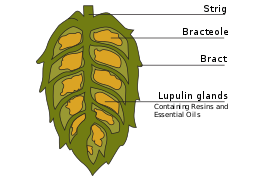



Hops are the flowers (also called seed cones or strobiles) of the hop plant Humulus lupulus,[1] a member of the Cannabaceae family of flowering plants.[2] They are used primarily as a bittering, flavouring, and stability agent in beer, to which, in addition to bitterness, they impart floral, fruity, or citrus flavours and aromas.[3] Hops are also used for various purposes in other beverages and herbal medicine. The hops plants have separate female and male plants, and only female plants are used for commercial production.[4] The hop plant is a vigorous, climbing, herbaceous perennial, usually trained to grow up strings in a field called a hopfield, hop garden (in the South of England), or hop yard (in the West Country and United States) when grown commercially. Many different varieties of hops are grown by farmers around the world, with different types used for particular styles of beer.
The first documented use of hops in beer is from the 9th century, though Hildegard of Bingen, 300 years later, is often cited as the earliest documented source.[5] Before this period, brewers used a "gruit", composed of a wide variety of bitter herbs and flowers, including dandelion, burdock root, marigold, horehound (the old German name for horehound, Berghopfen, means "mountain hops"), ground ivy, and heather.[6] Early documents include mention of a hop garden in the will of Charlemagne's father, Pepin the Short.[7]
Hops are also used in brewing for their antibacterial effect over less desirable microorganisms and for purported benefits including balancing the sweetness of the malt with bitterness and a variety of flavours and aromas.[3] It is believed that traditional herb combinations for beers were abandoned after it was noticed that beers made with hops were less prone to spoilage.[8]
- ^ "University of Minnesota Libraries: The Transfer of Knowledge. Hops-Humulus lupulus". Lib.umn.edu. 13 May 2008. Archived from the original on 5 March 2012. Retrieved 20 May 2012.
- ^ "Cannabaceae | Description, Genera, & Species". Encyclopedia Britannica. Retrieved 16 September 2020.
- ^ a b Schönberger C, Kostelecky T (16 May 2012). "125th Anniversary Review: The Role of Hops in Brewing". Journal of the Institute of Brewing. 117 (3): 259–267. doi:10.1002/j.2050-0416.2011.tb00471.x.
- ^ Willy H. Verheye, ed. (2010). "Hops and Hop Growing". Soils, Plant Growth and Crop Production Volume II. EOLSS Publishers. p. 194. ISBN 978-1-84826-368-0.
- ^ Hornsey, Ian S. (2003). A History of Beer and Brewing. Royal Society of Chemistry. p. 305. ISBN 9780854046300.
- ^ "Understanding Beer – A Broad Overview of Brewing, Tasting and Analyzing Beer – October 12th, 2006, Beer & Brewing, The Brewing Process". www.jongriffin.com. Jongriffin.com. Archived from the original on 15 March 2012. Retrieved 20 May 2012.
- ^ Michael Jackson (1988). The New World World Guide to Beer. Running Press. p. 18. ISBN 978-0-89471-884-7.
- ^ F. G. Priest; Iain Campbell (2003). Brewing microbiology. Springer. p. 5. ISBN 978-0-306-47288-6.